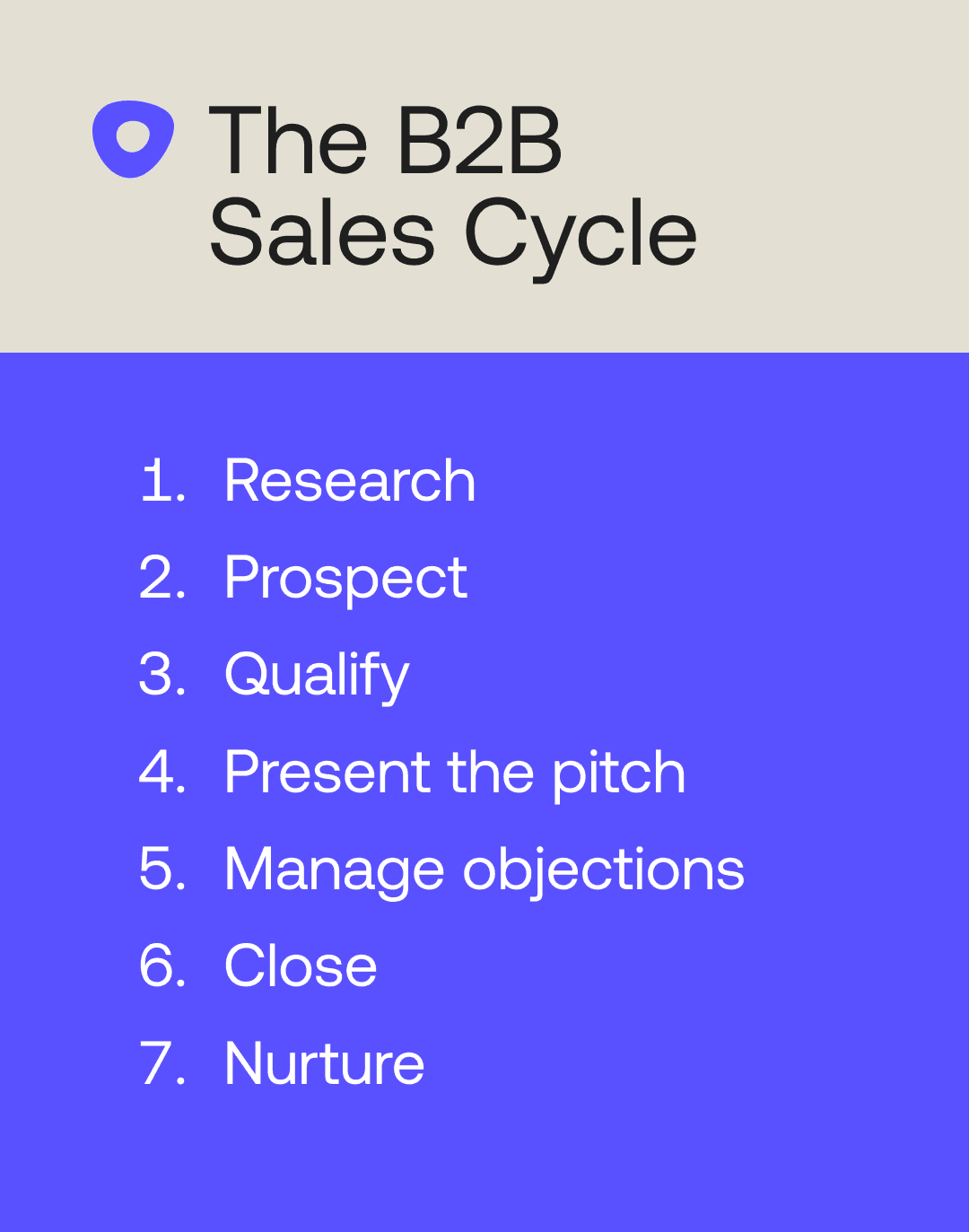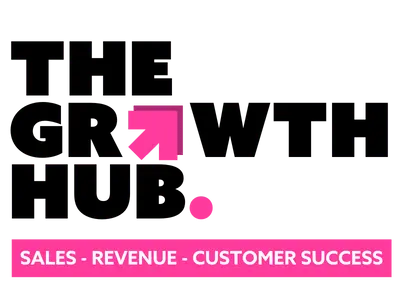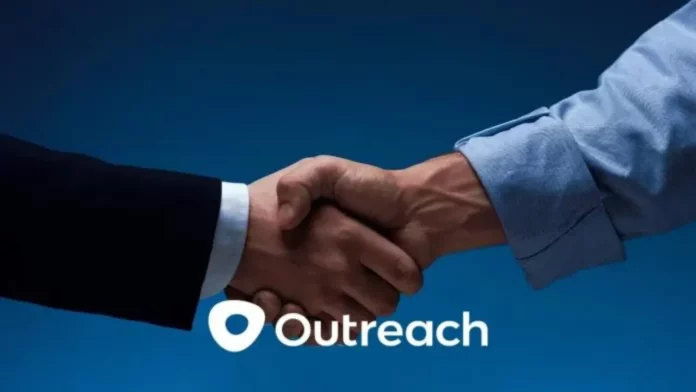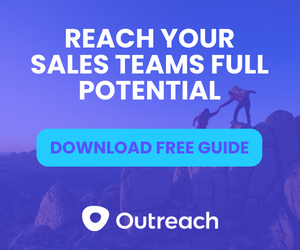B2B selling presents unique challenges. Deal cycles are longer, there are more stakeholders involved in the decision-making process, and sellers are expected to have expert-level knowledge about their products and services. Today, more businesses operate in a remote or hybrid capacity, which means that digital communication is a crucial skill for any rep. Read on to learn the basics of the B2B sales process.
What is B2B sales?
Business-to-business (B2B) describes the process of selling products or services from one business to another. It involves understanding the specific needs and goals of the buying business and providing tailored solutions to address them. B2B sales often require building relationships, effective communication, and demonstrating value to drive successful transactions in the business-to-business environment. A B2B company is one that sells to other businesses.
Common examples of B2B sales
B2B sales refer to a sales model or a category of selling wherein a business sells its products or services to another business. Because B2B sales usually involve higher price points, more complex processes, and several touchpoints over multiple channels, B2B companies need to maintain a team of highly-trained B2B sales professionals in order to drive revenue.
Here are six categories that would be considered examples of business-to-business companies.
Manufacturing
Manufacturers selling heavy machinery, specialized tools, or production equipment cater specifically to other businesses operating in manufacturing sectors. These B2B transactions revolve around delivering machinery that enhances operational efficiency, increases productivity, and helps businesses meet their production goals.
Software solutions
Software companies develop and offer specialized software solutions tailored to the needs of other businesses. Whether it’s enterprise resource planning (ERP) systems, customer relationship management (CRM) software, or project management tools, these B2B sales involve providing scalable and customizable software to streamline operations and improve productivity for businesses in various industries.
Professional services
Professional services include consulting firms, legal services, accounting firms, marketing agencies, and more. B2B sales in the professional services sector revolve around offering expertise, advice, and specialized services to help businesses overcome challenges, improve performance, and achieve their strategic objectives.
Business consulting and training
Business consulting and training provide valuable guidance and education to other businesses. These services can include management consulting, leadership training, sales training, or specialized workshops. B2B consultants and trainers work closely with companies to identify areas for improvement, offer expert advice, and empower employees to enhance their skills and knowledge.
Wholesale distribution
Wholesale distributors purchase goods in bulk from manufacturers and sell them to retailers or other businesses. Wholesale distributors often deal with a wide range of products, from electronics to consumer goods, and act as intermediaries, ensuring the smooth flow of products from manufacturers to end consumers.
Office supplies and services
Companies specializing in office supplies, stationery, furniture, and technology equipment cater to the needs of other businesses. These transactions involve providing essential supplies to maintain smooth office operations or offering services such as managed print solutions, document management, or office cleaning services.
Discover the Sales Execution Platform
See how Outreach helps sellers close over 2 million opportunities every month.
What’s the difference between B2B sales and B2C sales?
As their names imply, business-to-business (B2B) and business-to-consumer (B2C) sales primarily differ in their target customers. While B2B companies sell products and services to other businesses, B2C companies consider the general public (or certain segments of it) as their primary market and end consumers.
The main differences between B2B and B2C are as follows:
- Price point: B2B products and services generally have higher prices compared to many consumer goods.
- Size of addressable market: B2C companies target thousands to millions of consumers while B2B companies may just have a few to several hundred potential customers.
- Sales process complexity: B2C customers may easily decide to purchase on the spot while it takes patient lead nurturing before B2B buyers make a positive purchasing decision.
- Number of decision-makers: Only one individual is needed for a B2C purchase while multiple stakeholders are required to sign off a B2B deal. On average, B2B buying committees include 11 stakeholders, but that number can flex to upwards of 20.
- Sales methodology. B2B salespeople use sophisticated selling techniques and follow well-calibrated sales processes to succeed, such as MEDDPICC. B2C sellers also need to hone selling skills but operate in a less punishing environment.
- Customer service. To prolong and increase customers’ lifetime value, B2B companies place a high premium on customer experience, client satisfaction, and success.
- Marketing channels: B2B sales often rely on targeted marketing efforts through industry-specific publications, trade shows, and online platforms catering to businesses. B2C sales, on the other hand, utilize a broader range of marketing channels, including advertising through mass media, social media platforms, and retail spaces.
- Decision-making factors: B2B buyers make purchasing decisions based on factors such as ROI, long-term value, and meeting specific business needs. B2C consumers, on the other hand, may be driven by emotional factors, personal preferences, price sensitivity, and convenience.
- Relationship duration: B2B sales often involve longer-term relationships with clients due to the nature of ongoing business transactions and the potential for recurring sales. B2C sales, while also focused on customer loyalty, may have shorter-term interactions with individual consumers.
- Product customization: B2B sales often involve providing customized products or services to meet the unique requirements of business clients. B2C sales, while offering some customization options, typically involve selling standardized products or services to a larger consumer base.
- Sales volume: B2B sales may involve larger order volumes or higher contract values compared to individual consumer purchases in B2C. B2C sales often involve individual transactions with relatively smaller order sizes.
- Sales cycle length: B2B sales cycles can be longer and more complex, involving multiple stages such as lead generation, lead nurturing, proposal development, and contract negotiations. B2C sales cycles are often shorter, with consumers making more immediate purchase decisions.
- Sales velocity: B2B sales tend to have slower sales cycles compared to B2C due to the complexity of the selling process.
- Payment terms: B2B sales may involve negotiated payment terms such as invoices, contracts, and recurring billing agreements, allowing businesses to manage their cash flow. B2C sales typically involve immediate payment, either in-person or through online transactions.
Read more about B2B Sales vs. B2C Sales.
What is a B2B sales representative?
A B2B sales representative is a professional who uses strategic sequences and specialized selling methods to engage corporate buyers. Because corporate buyers tend to research products and services online before contacting a salesperson, these buyers are often well-informed and likely comparing competing products at the same time.
B2B sales representatives are responsible for various tasks to ensure an optimal B2B sales experience, including:
- Make and answer sales calls
- Manage sales emails
- Set meetings
- Conduct product demos/presentations
- Build rapport
- Handle objections
- Identify pain points and solve customer problems
- Prospect for potential clients
- Qualify leads
- Conduct needs analysis
- Create and deliver proposals
- Negotiate and close deals
- Upsell and cross-sell
- Manage accounts
- Collaborate with internal teams
- Perform market research and competitive analysis
- Manage CRM
- Continuously learn and improve
- Meet sales targets and quotas
- Attend industry events and trade shows
- Provide post-sales support
- Generate sales reports and analyze data
In cases where teams do not have account executives, B2B sales reps own virtually the entire sales cycle, engaging customers throughout the buyer journey — from prospecting and lead nurturing to closing deals.
Learn more about B2B sales reps: what they do and why they are important to a high-performing sales team.
What’s the difference between B2B outside sales reps and B2B inside sales reps?
In B2B sales, outside sales professionals often operate outside of an office because they are meeting with prospects and clients or presenting at an event. On the other hand, inside sales professionals engage clients remotely through cold calling, emailing, and video conferencing.
Inside sales professionals can close deals without ever personally meeting their customers. In contrast, outside sales reps almost always make a sale during or shortly after a personal meeting with clients.
This difference in engagement approach requires different skill sets and selling techniques required for either practice. For example, outside sales professionals leverage in-depth product knowledge and in-person communication skills while inside sales professionals become adept in the use of CRMs, a shared sales process, email, and social media.
Recently, however, the line between inside and outside sales has started to blur as outside sales reps begin using the same communication technologies as well as engagement strategies favoured by inside sales professionals.
Read more about B2B Inside Sales vs. Outside Sales.
What is the B2B sales process?
B2B selling is a complex process that requires a well-designed and executed B2B sales strategy in order to succeed. It follows a distinct process and uses a wide range of sales techniques for various buyer personas and selling situations.
The exact number and names of stages in your sales process will depend on your industry, company, and sales organization, but the B2B sales process is typically a 5- to 8-stage sales cycle.

Learn more about the B2B Sales Process (plus some tips and tricks for the modern sales pro).
What is a B2B sales funnel?
In contrast to the B2B sales process which focuses on the sellers’ perspective, the B2B sales funnel corresponds to the buyers’ journey. The sales funnel often serves as a visualization of a prospect’s proximity to or likelihood of making a purchase by identifying the cognitive or emotional phases the prospect undergoes in the buying process.
Most B2B sales funnels consist of 4 to 7 steps. Here is an example of a 7-step B2B sales funnel:
- Awareness
- Interest
- Decision
- Purchase
- Evaluation
- Delight/Dissatisfaction
- Repurchase/Attrition
Learn more about the B2B Sales Funnel (plus best practices).
How do you make a B2B sale?
The B2B sales approach involves several factors, including seller competency, sales process effectiveness, product fit, available alternatives, and the buyers purchasing capability and willingness to adopt.
To make all these moving parts work together, businesses need to:
- Build a responsive B2B sales strategy
- Determine the best B2B sales techniques for their teams and ideal customers
- Create well-calibrated playbooks and sequences for their sales reps to follow
- Measure and improve performance
B2B sales techniques
There is an overwhelming number of B2B sales methodologies and frameworks to choose from. While they all claim to be effective, not all will fit your business, your sales organization, or your target customers. Some methods might work well for a specific industry but not others, while other methods succeed only if they fit the type of customer accounts in your portfolio.
Some of the more popular B2B sales techniques and methodologies include:
- Solution Selling
- The Challenger Sale
- Account-Based Sales
- Value Selling
- The Sandler Selling system
Learn more about these 5 popular sales techniques (plus the pros and cons).
To determine whether a B2B sales technique or a specific sales sequence positively impacts a business, sales organizations identify and measure key performance indicators (KPIs). KPIs are agreed-upon metrics used in assessing a sales organization’s performance in different areas such as profitability, sustainability, and efficiency. They are also used to discover trends and to evaluate the productivity and performance of individual sellers.
Common B2B sales KPIs include:
- Quota attainment rate
- Average deal size
- Sales velocity
- New leads generated per month
- Win rate
B2B sales challenges
B2B companies tend to confront several common challenges. The most pressing issues in B2B sales include:
- Sales and marketing misalignment
- Competition for a limited number of potential customers
- Resistance to technology adoption
- Entrenched but outdated sales mindset/culture
- Seller skills/training deficiencies
In 2022, in the aftermath of the pandemic and on the heels of economic uncertainty, the greatest challenge to B2B sales is efficiency. Here are some of the resources we have for adjusting your B2B sales strategy in an unpredictable market:
- Webinar: How top-performing teams use sales tech differently
- Ebook: The sales leader’s Guide to improving rep productivity
- Article: How to increase visibility and save at-risk Deals
B2B sales tips
Here are some tips for improving B2B sales performance:
- Personalize customer communications. Use technology to help you personalize at scale.
- Never skimp on continuous seller training. B2B buyers are smart — they prefer to engage professionals who demonstrate expertise and empathy.
- Build genuine rapport through active listening, critical thinking, and asking the right questions. Go for omni-channel outreach (mobile, social media, email, events, sales calls, etc.)
- Consider establishing a dedicated sales ops and a sales enablement team.
- Go beyond CRM and marketing automation. Embrace new technologies such as sales engagement and conversation intelligence. Use data to help you make smarter decisions and playbooks.
- Encourage, monitor, and display positive customer feedback. Showcase customer success stories and incorporate case studies into your sales playbook.
- Establish full strategic and tactical alignment among all customer-facing units from marketing and sales to customer success.
What is the future of B2B sales?
B2B sales are in a state of rapid transformation. The line between inside sales and outside sales is fading while best practices for consumer sales — especially when it comes to personalization — are becoming mainstream in B2B.
Sales tools introduced just a few years earlier (such as revenue intelligence platforms) have already become necessary for survival. Technology and buyer-centricity are shaking the ecosystem as AI and machine learning empower teams to scale both customer engagement and revenue.





